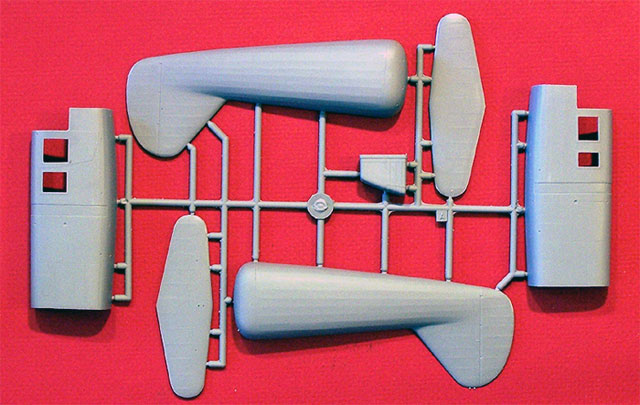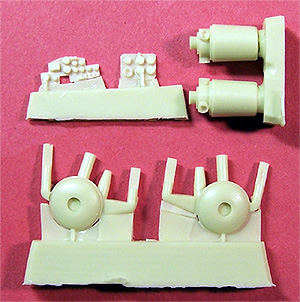|
Focke-Achgelis Fa 223

Special
Hobby, 1/48
S u m m a r y
|
|
Catalogue Number: |
SH48020
- Focke-Achgelis Fa 223 Drache |
|
Scale: |
1/48 |
|
Contents and Media: |
84 pieces in gray styrene; 8 clear parts; 4
resin pieces; 33 pre-colored photo etched
pieces and 31 regular photo etched pieces |
|
Price: |
USD$42.96 available online from Squadron.com |
|
Review Type: |
FirstLook - In Box |
|
Advantages: |
Well moulded; nice surface texture; high
level of detail inside and out; good quality
clear parts with well defined frames; |
|
Disadvantages: |
Packaging style
resulted in some damage to clear parts in
transit; |
|
Recommendation: |
Highly
Recommended |
Reviewed by
Matt Swan

Special Hobby's 1/48 scale Fa 223
is available
online from Squadron
Designed for the Deutsche Lufthansa as a six seat passenger
aircraft, this odd looking bird first flew in August 1940.
With the war already in progress it was decided to utilize it in
a military format. It was planned to use it for rescue operations,
antisubmarine patrols, reconnaissance and cargo transportation.
Powered by one 1,000-horsepower radial piston engine it could reach
a maximum speed of 109 miles per hour, could carry two 250kg bombs,
was equipped with a rescue cradle and winch, and had a
reconnaissance camera and a jettisonable 300 liter auxiliary fuel
tank.
Initially 30 pre-production aircraft were ordered but only ten were
completed before the factory was destroyed by Allied bombs. A new
plant was constructed near Stuttgart where seven more aircraft were
manufactured. In early 1942 the type was finally considered ready
for operational testing and trials began. Encouraged by early
results where the aircraft assisted ground troops an additional 100
aircraft were quickly ordered but once again, Allied bombs cut this
production run short after only eight had been assembled and six of
these were destroyed in the raid. Yet another factory is put up,
this time in Berlin with a projected production capacity of 400
aircraft per month but only a single unit was produced before the
war ended.
In the end only ten or eleven aircraft ever made it to operational
status but these established several notable records like being the
world’s first helicopter to achieve production status and to be the
first helicopter to fly across the English Channel. However, when
the war ended the story of the Fa 223 did not, development was
continued in France as the SA 3000 and in Czechoslovakia units were
assembled from salvaged parts as the VR-1.
For such a historically noteworthy aircraft I find it somewhat
amazing that until now, it had never been produced in 1/48 scale
injection. The model arrives is a compact lift top box with four
sprues of light gray, slightly soft plastic parts and a single sprue
of clear parts all packaged in a single poly bag. This style of
packaging caused the main canopy piece to be broken off the sprue
creating a small fracture dead center in the front pane and several
small abrasions were found on the top of the canopy. The clear parts
do show excellent clarity and well defined raised frame lines. They
also fit well to the fuselage piece.

Click the thumbnails below
to view larger images:
The kit also includes some really nice photo etched
pieces, two frets with one of them being precolored. The
colored set covers the instrument panels, instrument
details and seat belts while the second set covers
additional interior and exterior details. Instrument
panels are also provided as pure resin parts. You could
dispose of the PE panels and paint the raised faces on
the resin part or sand the face down, attach the PE
pieces and obtain a little better depth to the parts.
 The
little bag of resin details also includes rotor heads and
transmission boxes that display a good level of detail and standard
pour stubs. The
little bag of resin details also includes rotor heads and
transmission boxes that display a good level of detail and standard
pour stubs.
Returning to the gray plastic pieces the surface of all parts is
nicely smooth with not sink marks and there does not appear to be
any flash on the parts sprues. Inside the fuselage forward section
there are several small injector pin marks that will have to be
removed. Interior detail looks to be outstanding on this kit with
lots of fine tubular structure and instrument detail. With the large
clear greenhouse this is a definite plus for the kit.
Exterior fabric detail for the aft section looks good and we gets
lots of finely cast tubular structures to support the rotor
housings. I think one of the challenges to this kit will be removing
all these pieces from the sprue without causing damage, followed by
lining them all up properly. Some supporting cable structure will
have to be scratch built from fine wire, stretched sprue or
invisible thread but placement for all this is shown in the
instructions. All the large kit pieces fit together well during test
fitting (no alignment pins on this kit) but it does look like
attaching the forward fuselage section to the aft section could be a
little tricky, if fact, it looks like there could be quite a bit of
tricky assembly to this kit.
Parts inventory gives us eighty four pieces in gray polystyrene,
eight clear parts, four resin pieces, thirty three pre-colored photo
etched pieces and thirty one regular photo etched pieces for a grand
total of one hundred sixty pieces in the box.
Decals and Instructions
Instructions come as a nice little booklet of fourteen pages
beginning with a good historical back ground of the type in both
English and Czech. Following this is a complete parts map. There are
eighteen exploded view assembly steps that are very well illustrated
and include several color call-outs by Gunze-Sangyo color numbers
only. Four full pages are devoted to exterior painting and decal
placement for four different units. In these steps exterior colors
are given by Gunze-Sangyo numbers, by color name and by RLM number.
The kit decal sheet is a small sheet that includes the basic unit
marking for four aircraft. The decal sheet does not include and
service stencils or warning markings which seems somewhat odd for a
German aircraft. The decals appear to be nicely thin and have good
color density and print registration. Swastikas are provided in a
politically correct manner being in two pieces that we have to
assemble. Previous experience with Special Hobby decals indicates
they behave well with standard setting solutions and are not prone
to silvering.
It seems that this kit should appeal to a wide range of
modelers covering both the World War Two and helicopter
aficionados.
The kit seems to be well engineered and test fitting
shows a generally good fit of all major components.
Interior details are very good as are exterior details.
Kit decals seem adequate but the lack of service
stencils makes me hopeful that the aftermarket will soon
come to our rescue with a better marking sheet.
Considering all the fine tubular structure that needs to
be assembled I don’t feel this kit is appropriate for
beginners but should present little problem to more
accomplished modelers.
This is a historically significant aircraft and a kit
that I recommend you have in your collection.
Highly Recommended.
Review and Images Copyright © 2006 by
Matt Swan
Page Created 20 March, 2006
Last updated
20 March, 2006
Back to
HyperScale Main Page
Back to
Reviews Page
|
Home | What's
New | Features
| Gallery |
Reviews | Reference
| Forum
| Search